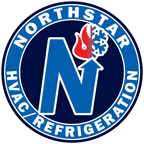CO2 Refrigerant: Just the Facts
Written by Ed Rice
Introduction
In today’s world, businesses are increasingly focused on finding more sustainable and environmentally friendly solutions for their refrigeration needs. CO2 (R-744) is gaining traction as one of the leading refrigerants due to its low environmental impact and high efficiency. But what makes CO2 stand out among other refrigerants? Let’s explore seven key facts that make CO2 a future-proof refrigerant for commercial and industrial applications.
Fact 1. CO2 Uses Less Energy
Compared to other synthetic refrigerants, CO2 operates more efficiently in many refrigeration systems. CO2’s unique thermodynamic properties allow for reduced energy consumption, which translates to lower operating costs. This is especially true in systems designed for low-temperature applications like ice rinks, industrial cooling, and supermarkets, where energy efficiency is critical to minimizing costs.
Fact 2. CO2 is Widely Available
One of the major advantages of CO2 is its availability. Unlike synthetic refrigerants that are subject to tariffs and strict regulations, CO2 is naturally abundant and can be produced without complex chemical processes. Its production isn’t restricted by international trade or heavy regulatory oversight, making it a cost-effective and sustainable option for businesses worldwide.
Fact 3. Lower Insurance Risk
CO2 offers several safety advantages over other refrigerants:
No or Little Product Loss: In the event of a leak, CO2 poses no significant risk to stored products, minimizing potential losses.
Lower Impact to the Nearby Community: CO2 is a naturally occurring gas with no harmful effects on the environment in the case of leakage.
Lower Fire Risk: As an A1 refrigerant, CO2 is non-flammable, reducing the risk of fires in refrigeration systems. This often leads to lower insurance premiums for facilities using CO2 systems.
Fact 4. CO2 is an A1 Refrigerant
CO2 is classified as an A1 refrigerant, meaning it has no flammability and is considered safe for use in many applications, especially in environments where safety is a top concern. Other refrigerants, such as those in the A2L classification, are mildly flammable and require additional safety measures, which increases both complexity and cost. CO2’s safety classification makes it ideal for use in food production, cold storage, and other sensitive environments.
Fact 5. CO2 Has a Low GWP
One of the most important environmental benefits of CO2 is its Global Warming Potential (GWP) of 1. In contrast, popular refrigerants like R410A have a GWP of 2,088, making them far more harmful to the environment. As global regulations tighten around refrigerants with high GWP, CO2 stands out as a future-proof option that meets current and future sustainability standards.
Fact 6. CO2 is Future-Proof
CO2 refrigerant systems are considered future-proof for several reasons:
Less Regulated: CO2 is a natural refrigerant and is subject to far fewer regulatory restrictions than synthetic refrigerants, which are facing increasing global phase-downs due to their high environmental impact.
Stable Thermodynamic Properties: Unlike synthetic refrigerants, CO2’s properties do not change over time, making it a reliable option for long-term use.
Lower Maintenance Costs: In the event of a leak, CO2 systems require less maintenance than those using synthetic refrigerants. This reduces downtime and keeps systems running efficiently with minimal interruption.
Fact 7. CO2 vs. R410A
To understand the advantages of CO2, it’s important to compare it with one of the most commonly used refrigerants, R410A. While R410A has been widely used in various cooling applications, it has a GWP of 2,088, making it a major contributor to global warming. With increasing regulations on high-GWP refrigerants, R410A is expected to be phased out, leaving businesses searching for more sustainable options. CO2, with its GWP of 1, is a clear choice for environmentally conscious businesses looking to future-proof their operations.
Conclusion
CO2 refrigerant is rapidly becoming the go-to choice for businesses looking for an environmentally friendly, cost-effective, and efficient solution. With its low GWP, energy efficiency, safety benefits, and minimal regulatory restrictions, CO2 is not only a smart choice today but also a long-term solution for the future of refrigeration.
If you’re interested in learning more about CO2 refrigerant systems or how they can benefit your business, feel free to contact us. Our team is here to help you make the transition to a more sustainable refrigeration system.
(508) 888-3692
www.northstarhvacr.com
Edward Rice
Director of Marketing,
Northstar Refrigeration, Inc.
95 Camelot Drive, Unit 1,
Plymouth, MA 02360
erice@northstarhvacr.com www.northstarhvacr.com
p: (508) 888-3692 x115
m: (508) 561-8638



